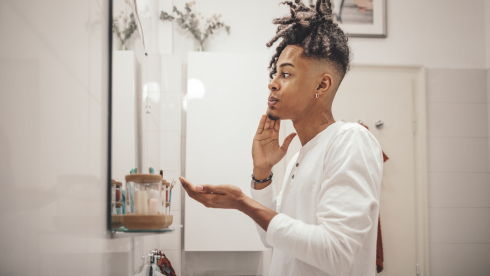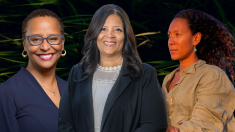Step back with me, if you will, into 1984. I was a chubby five-year-old with a grill full of missing teeth, a massive side ponytail and, according to pictures from that era, a seemingly endless wardrobe of Adidas track jackets (but interestingly enough, no Adidas). My mother and I lived in a small, wood-paneled apartment that she decorated with the obligatory wicker chair—we had one too, Michelle Obama!—and standard masterpieces of Black art.
There were, at that time, three significant days in our household: Sundays, which were spent sitting on archaic wooden pews at Mt. Sinai AME Church; Saturdays, my mom’s housecleaning day, punctuated by a soundtrack that usually included The S.O.S. Band and Parliament Funkadelic; and Thursdays, when I scrambled to get my homework done immediately after school so I could watch The Cosby Show at 8 p.m. I wasn’t going to be the one left out of the conversation about it the following day in pre-water cooler chat for the kindergarten set.
Even though we were very blue-collar, very working-class folks, the weekly ins-and-outs of the Huxtables resonated immediately with my family. It did with most of the people in our circle too, and not just the Black ones. Everybody loved The Cosby Show. My teachers, my neighbors, the older ladies at church, the crotchety crossing guard who scolded us through the crosswalk, everybody. My friends and I crushed on Theo and lusted after Denise’s wardrobe, saw bits of ourselves in Vanessa and awwwed over Rudy’s cute one-liners—even though we were the same age. And I, in my little fatherless world, decided that since I didn’t know my real dad, I was at liberty to make Heathcliff Huxtable my honorary one. (He’s since been replaced by Frankie Beverly, but there’s no love lost.)
Because it was just me and my mom, the Cosbys showed me what family life might’ve been like if I had a father and siblings and a stunning brownstone in Brooklyn instead of a two-bedroom apartment with offensive wood paneling. Even though it seems fantastical, it’s still what I’ve aspired to. I’ve learned, as a grown-up, that the idealism of a happy, healthy marriage between a Black man and woman isn’t just the stuff of fictional families on TV sitcoms, no matter what dismal statistics and surveys say. I’ve seen it play out in real life too, but I’ve always held what the Huxtables represent in high esteem. Claire and her bad self is still one of my personal she-roes.
The Cosby Show just so happened to debut in 1984, a year that urban Black communities were being mollywhopped by the explosion of crack. Folks were being impacted left and right, either because they were taking it and getting hooked or selling it and getting knocked, and to exacerbate that, the trickle-down effects of the Reaganomics machine didn’t trickle down to too many households that I knew. People were struggling. Since Bill Cosby had a lot of creative direction over the storylines and characters, he, and the show itself, took plenty of criticism for not addressing more of the social issues that were bubbling over beyond the imaginary doorstep of 10 Stigwood Avenue (Add that to your Cosby Show trivia). And while The Cosby Show made a few vague attempts to directly confront topics like teen pregnancy and economic red-lining, the show was more of a 30-minute escape from the other 23.5 hours of daily reality. And that had value, too.
Today marks the 20-year anniversary of the last episode of The Cosby Show. For eight glorious seasons, they portrayed another aspect of Black life, breaking up the monolith that had been the standard in Black television. I mean, I love Sanford and Son and The Jeffersons, but man, was Healthcliff Huxtable a nice reprieve from angry, trash-talking little Black men, and he was a lot more stylish in the process. (Not to mention that he wore Lincoln University sweatshirts on a regular basis—hail hail Lincoln!—and represented for other HBCUs, too.)
Two decades later, the cast is still defined by time as part of TV’s most loveable family and no one is headlining the National Enquirer or shaking shoppers down for change outside of a Piggly Wiggly, which is always a good thing: Phylicia Rashad won a Tony award in 2004 for her turn in A Raisin in the Sun, Malcolm-Jamal Warner picked up the Cosby-like torch with BET’s Reed Between the Lines, Tempestt Bledsoe is hosting Clean House on the Style Network, Keisha Knight Pulliam has a recurring role on Tyler Perry’s House of Payne, Lisa Bonet pops up occasionally in an apparently selective roster of major and independent film releases, Raven-Symone (who joined the cast in season six as Denise’s stepdaughter, Olivia) is an actress, entrepreneur and a jagillionaire, and Bill Cosby, the man himself, of course crops up at random times to offer up inflammatory comments on how younger generations basically suck—but with love.
The legacy of The Cosby Show started in the little apartment I grew up in and continues in the one I’m sharing with my daughter, who is 13 and at that age where nothing created before the year 2000 could possibly be relevant or remotely cool. But she loves the show too, even knows episodes by heart—the Gordon Gatrell shirt debacle and the anniversary songs performed for Cliff’s parents are our favorites—and watches it like she was with me back in the days of the original airings, when I was living vicariously through the Huxtables, 30 minutes at a time every Thursday evening. Other Black TV families have come and gone: the Kyles in My Wife and Kids, the Paynes in the aforementioned House of Payne. But no one has come close to Heathcliff, Claire and their clan. And I’m pretty sure the bar has been set so high, no one ever will.













